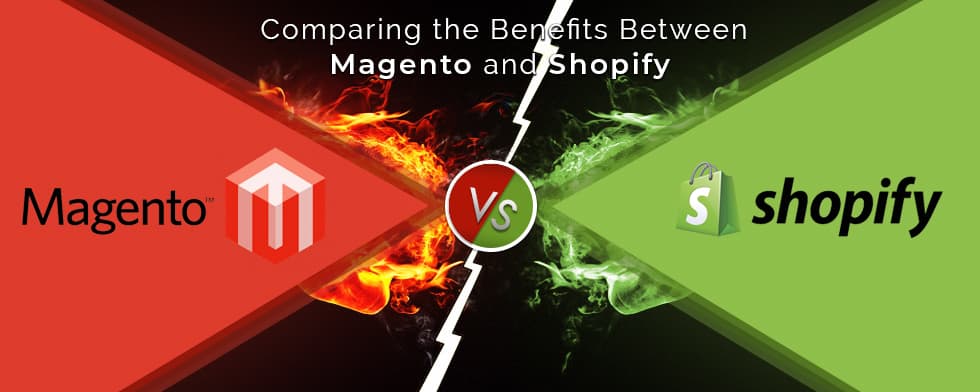
Location, as we know, have always played a major role in determining the success of any company. Nobody wants to set their shop in a secluded area devoid of any customers. Similar logic applies while you try to set an online store but with a minor difference, you have to choose an e-commerce platform rather than an actual location.
Choosing an e-commerce platform may appear to be a minor difference but in no way, it is to be mistaken for a minor problem. What’s the point of establishing a nice-looking online store brimming to the top with a variety of products where customers cannot find you? It gets, even more, tougher due to the vast majority of options available (each claiming to be no.1) to pick from.
But if you look at things more closely, you will realise that there are very few platforms on top such as WooCommerce, BigCommerce, Shopify, Magento, Big Cartel etc. among which the main competition is actually between two e-commerce giants namely Magento and Shopify. Let’s learn a bit more about them.
Magento, originally developed by Varien Inc. in 2007 and currently owned by eBay, is an open source e-commerce platform written in PHP. Magento website development services are currently available in two versions namely Community (which is free with basic features) and Enterprise (which is paid with advanced features) edition.
Shopify, on the other hand, was launched by Snowdevil founders in 2006 by Daniel Weinand, Scott Lake and chiefly Tobias Lütke as an API (or Application Programming Interface) platform. It is basically a cloud-based e-commerce store platform written in LIQUID which enables the Shopify web design and customization to be extremely user-friendly.
Now that you are aware of them, let’s dive in a bit deeper and learn about their various benefits and what distinguishes them.
The first thing any client will look for is the popularity ratio and here Shopify seems to hold an upper hand by hosting more than 2,40,000 websites on its domain with Magento slightly behind with 1,60,000 sites to claim its own.
But this tells more about the businesses that own them, not efficiency ratio as Shopify is mostly popular among small businesses whereas Magento is more suitable for medium or large companies.
Both Shopify and Magento provide you with the facility to build your websites from scratch choosing from various themes available which are highly responsive with robust customization capabilities.
The difference lies in the usability, where Shopify works on the drag and drop philosophy enabling easy theme customization, Magento with the help of Bluefoot (a CMS and page builder module) enable clients to build a uniquely designed website.
When it comes to flexibility, Magento is the clear winner. Shopify with a little over 100 apps and Add-ons comes nowhere near Magento which provides more than 5000 extensions to its clients owning no doubt to the open source nature of the platform.
Since it’s an open source network, the Community edition of Magento is completely free to use and its enterprise edition costs vary according to company’s needs. However, hosting 3rd party services may cost a little.
Shopify, on the other end, works on SAAS (software-as-a-service). Initially, you get a free trial period of 14 days after which it ranges between $29 to $179. Though you may save on hosting as Shopify is self-hosted.
Shopify offers its users a smooth experience when it comes to payment options. With 70 payment getaways, Shopify clearly holds a major advantage here over Magento which offers far less to its users though it can be increased via 3rd party add-ons.
Here you will have to choose according to your requirement as both offers bulk upload features with add and edit options. You can add unlimited products on Shopify with its monthly plans with only one exception i.e. starter pack, which costs $14 and will limit your stored items to 25 only.
With Magento you don’t have to worry about product management as it allows virtually unlimited products but faces another issue, it weighs down your site’s loading time which you won’t find in Shopify.
When it comes to generating traffic, SEO plays a very important role as it drives more organic traffic to your stores via search engines. Both platforms are extremely SEO friendly and provide extensive SEO capabilities, however, Magento ranks slightly higher in a study of SEO scores with Shopify closely behind.
The speed with which any website loads determines its success rate. If one compares Magento 1.0 with Shopify, Shopify is the clear winner, but things have changed with the coming of Magento 2.0 which is incredibly fast compared to its earlier version.
When it comes to user experience, a lot of people seem more satisfied with Shopify than Magento. Even the admin panel of Shopify requires no advance knowledge and easy to maintain whereas, with Magento 1, clients need professional help due to its complexity of setting up their store. But Magento 2.0 with its user-friendly admin panel and readymade extensions have resolved that issue which Magento 1.0 had.
It’s hard to make a clear assumption as to who should be the winner as both have their advantages and disadvantages. But what we can gather from the available information is that both Shopify and Magento provide excellent hosting platforms best suited according to the customer’s needs. So choose wisely.